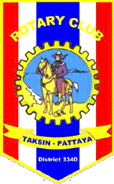- HEADLINES [click on headline to view story]:
-
Sailors at work and play with Thai children
-
Thai students thank American Sailors
-
Regent’s School holds rockin’ Senior Formal at Hard Rock Hotel
-
U.S. Seabees go back to school in Thailand
-
St. Andrews welcomes the Head Elect - Mr. David Lowder
-
Good as Gold
|
|
Sailors at work and play with Thai children
By Journalist First Class Joseph E. Krypel U.S. Navy Public Affairs
“I very appreciate the people of the U.S. Navy. I
have no real family, but today I feel like I have more family than anyone
in the world,” said Nong Ai, an educationally challenged seventh grade
student from a nearby boys’ orphanage.
He said he was very happy to see the active duty and
Reserve Sailors from three U.S. Navy ships who teamed to refresh the faces
of a local school and its children during Cooperative Afloat Readiness And
Training (CARAT), an annual exercise in the Western Pacific.
Nong went on to say that he felt the Navy made things
fun, and showed a great interest in all the students of his school. “I
like to see the differences in English, and the Navy help me better
understand.”
More than 20 CARAT Sailors, including some Reservists,
responded to the call for volunteers. Weathered gate walls at Pattaya #7,
a local school, needed painting. The Sailors gave the wall a facelift
along with putting many smiles on the children and teachers.

Newport,
Tenn. native EW2 (SW) Terry Zutshaw from USS Vincennes (CG 49) signs
autographs for students at the Pattaya #7 school. Zutshaw and other
Sailors volunteered their liberty time to paint a gate wall around the
school during a community outreach project as part of this summer’s
Cooperative Afloat Readiness and Training, an annual exercise in the
Western Pacific. Once the work was done, the Sailors and children played
and spent time together learning each about others’ cultures. CARAT, a
series of bilateral exercises, takes place throughout Southeast Asia each
year. It aims to build interoperability and regional cooperation. Sailors,
Marines and Coast Guardsmen from USS Anchorage (LSD 36), USS Vincennes (CG
49), USS George Philip (FFG 12) and USCG Morgenthau (WHEC 722), are also
taking part in this eighth annual CARAT exercise. U.S. Navy Photo by JO1
Joseph Krypel.
“We like very much the help of the U.S. Navy,” said
school principal Manas Kongwattana. “This is such a positive experience
for the children and teachers alike. It provides new motivation for
learning about how people, regardless of language, offer their hands to
help one another.”
Most of the school’s 1,500 students come from
families earning what equates to $100 U.S. a month. “The children do not
get much, but I think they will always remember the men of the U.S. Navy
that played with them and made their school a nicer place to be,” said
YWCA-Thailand President Premrudee Jittivuhikarn.
“We offer some scholarship money for their books and
uniforms, but the Navy’s involvement covers the things we can’t always
do.”
By the day’s end, the work was done and a soccer game
broke out between the Sailors and students. The groups chatted about
cultural differences and life in the Navy.
EW2 (SW) Terry P. Zutshaw, a 22-year-old Sailor from
Newport, Tenn., serves aboard USS Vincennes (CG 49). Zutshaw said he
volunteered his free time to help the children have a better-looking
school.
While skeptical as to how the entire project was going
to work out, Zutshaw is extremely happy he made the decision he did. “I
don’t have any children of my own. Being able to give back to a
community, even if it’s not the one you came from, just makes you feel
good. No child should have to live or learn in anything other than perfect
conditions.”
PC3 Wallace L. Perrault of Baton Rouge, La. was really
taken back by the children wanting his autograph. “I don’t know why
they started, but evidently they really consider us celebrities. I must
have signed autographs for more than two hours. It was really kind of
cool.”
Perrault is a two-year Navy veteran serving aboard the
USS George Philip (FFG 12).
The Pattaya #7 School is a city school with a faculty
of 51. As part of the community relations project, Sailors brought a
variety of sports balls for the school. In addition to the Navy presence,
the cooperation of this project included members from the local Rotary and
YWCA.
While the Sailors and children alike enjoyed their time
together, the day had to return to schooling at some point.
So, the children returned to their books, and the
good-will ambassadors of the U.S. Navy continued their learning experience
by traveling and looking around the town of Pattaya.
Some of the souvenirs they’ll be taking back to the
States will no doubt be their memories of Nong and the other students at
Pattaya #7.
Thai students thank American Sailors
By JO1 Joseph Krypel U.S. Navy Public Affairs
In this rural region of Southeast Asia, Navy Seabees worked
side-by-side with Royal Thai Marines to make the lives of students a little
better.
Sailors from Naval Mobile Construction Battalion 1, out of
Gulfport, Miss., accomplished the mission. And, they went the extra mile,
building extra structures and making enhancements at the Wat Prachoommit
Bamroong School.

CECN
Gregory Pomorski, from Toledo, Ohio, and his Thai shipmates PO3 Wanchai Kamsakol,
left, and Chief Petty Officer First Kamol Chalong lay electrical groundwork for
a multipurpose building at Wat Prachoommit Bamroong School. A team from Mobile
Construction Battalion 1 out Gulfport, Miss., is in Thailand for the annual
Cooperation Afloat Readiness and Training exercise. This bilateral exchange aims
to increase interoperability. Photo by PHAN Jimmie Crockett.
“I like to thank all the people - U.S. and Thai - for
making my school much better,” said Danuvat Saratana, 8. “All are very
friendly, and we love very much what they do for us.”
An American five-man team arrived at the school the end of
May to meet with their Thai counterparts. Together, they mapped out what almost
20 U.S. Seabees and 25 Thai Marines would accomplish during the annual
Cooperation Afloat Readiness and Training exercise which takes place in Thailand
every summer.
CARAT is the Navy’s premier bilateral exercise in the
Western Pacific. It aims to enhance regional cooperation. In addition to
operational exercises that refine navigation and seamanship skills, community
outreach programs like the Seabees’ project rounds out the CARAT plan.
“Our primary function as an advanced party was to access
the location and begin work on a new 25-by-75 multipurpose structure for the
school,” said project leader BU1 (SCW) Wade Smith of Oakvale, Miss.
“Not only did we complete the structure early, but we used
leftover supplies and funds to move on to a couple of other projects the school
needed done.”
With one project down, the combined construction team took on
two more: building a block wall, specifically requested by the school, and
pouring a concrete ramp that helps drain water away from the cafeteria area.
“Right now, the kids are ankle deep in water when it rains
because of the drainage around their cafeteria. Since we came in under budget on
the main project, we’re using the balance to clean that up and keep ‘em
dry,” said Smith.
“This accomplishment provides better education facilities
to our students
and a great boost to our school,” said Paiboon Vitayakom, principal at Wat
Prachoommit Bamroong School.
The primary school has more than 200 students; some of them
are in the special education program. Children from fourth grade to the U.S.
equivalent of the twelfth grade attend the school that has only nine teachers.
CECN Gregory A. Pomorski from Toledo, Ohio supervised the
electrical aspects of the Seabee project.
“The Thais have no ground system when they do electrical
work, so this was a new concept for them. But when it’s all said and done,
they said they were very happy to have learned a new method in electrical
construction.”
An official ceremony turning the completed projects over to
the school’s administrators takes place near the end of CARAT Thailand.
U.S. Coast Guardsmen, Sailors and Marines from across the
United States are taking part in CARAT and work with their international
counterparts in Indonesia, the Philippines, Singapore, Malaysia and Brunei as
well.
Regent’s School holds rockin’ Senior Formal at Hard Rock Hotel
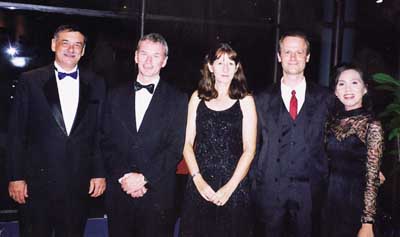
Proving
that even the over 18’s could enjoy the evening - Regent’s School
Headmaster, Mr Simon Leslie, together with colleagues Mr and Mrs Deveney
and Mr and Mrs Casper.
The Regent’s School Senior Formal was held recently
at Pattaya’s own Hard Rock Hotel. The Senior Formal has become an annual
event on the school calendar and is eagerly awaited by students who see it
as a grand celebration of the end of the school year, and for some, the
completion of their secondary school studies.
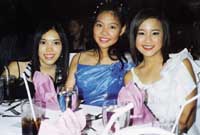 Happy
trio, Jan, Kluay and Ying. Happy
trio, Jan, Kluay and Ying.
This year the crowd of around 100 staff and students
were a dazzling sight to behold as they arrived in their formal evening
attire! A very smart looking Quincy Tanner and Pimsuree Mutaskun were
voted King and Queen of the evening.
After a wonderful dinner and speeches it was time for
the ‘action’ part of the evening - dance time! With great enthusiasm
everyone took to the floor to dance the night away. Fong Casper and Alex
Kudinov were duly pronounced ‘Dance Champions’ after showing their
finesse at the Waltz and Salsa (all those weeks of practice paid off!).

The
Regent’s girls get-together - looking fabulous in their formal wear.
This year’s Formal was voted ‘the best ever’ and
thanks must go to the Hard Rock Hotel for such an enjoyable night.
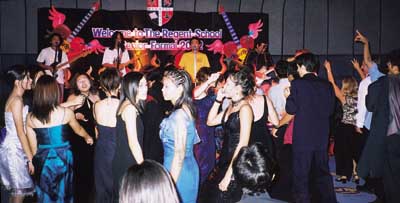
Time to dance
the night away.
U.S. Seabees go back to school in Thailand
By JO1 Joseph Krypel U.S. Navy Public Affairs
Learning was a common theme when almost 20 Seabees
arrived in Thailand to build a multipurpose structure for a local school
here as part of the annual Cooperation Afloat Readiness and Training
exercise.
The Sailors worked closely with Thai Marines on several
refurbishing projects after building the structure for the school.
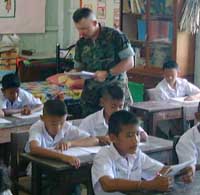 Gulfport,
Miss., native BU 1 (SCW) Wade Smith of Naval Mobile Construction Battalion
1 helps a class of Thai students speak English at the Wat Prachoommit
Bamroong School in Central Thailand. NMCB 1 built a multipurpose building,
giving students a sheltered place to eat and play. NMCB 1 is in Thailand
supporting this summer’s Cooperative Afloat Readiness and Training, an
annual exercise in the Western Pacific. U.S. Navy Photo by PHAN Jimmie
Crockett. Gulfport,
Miss., native BU 1 (SCW) Wade Smith of Naval Mobile Construction Battalion
1 helps a class of Thai students speak English at the Wat Prachoommit
Bamroong School in Central Thailand. NMCB 1 built a multipurpose building,
giving students a sheltered place to eat and play. NMCB 1 is in Thailand
supporting this summer’s Cooperative Afloat Readiness and Training, an
annual exercise in the Western Pacific. U.S. Navy Photo by PHAN Jimmie
Crockett.
Although they hope their work makes it easier for
students to concentrate on their studies, the Seabees learned a lot too.
“We take so much for granted,” says BU2 Russell E
Harbaugh of Dorchester, Il. “Our everyday tools consist of power saws,
drills, welders - just a lot of ‘power tools.’”
“These Marines get as much done without them, and the
job is just as good. In fact, they get a lot more done with their
conventional tools than we would. They are really top notch.”
Royal Thai Marine Chief First Class Kamol Chalong says
he and his shipmates benefit from working with their American
counterparts.
“We have learned so much from each other. We share
tools. We share sweat. We share accomplishment.”
The students also had some learning to do, in fact many
of the Navy Seabees used their breaks to help teachers in the classrooms.
“I loved teaching English to these kids,” said BU1
(SCW) Wade Smith of Oakvale, Miss. “They only problem they’ll face now
is that they all have a southern drawl.”
All the builders agreed.
The U.S. Seabee saying, “We build; we fight,” and
the Thai Marine construction motto: “To build a way to fight” was
overshadowed by: “We build together.”
St. Andrews welcomes the Head Elect - Mr. David Lowder
St. Andrews International School formally welcomed the
Head Elect, Mr. David Lowder, in a school assembly during his recent visit
to Thailand 1st - 6th June. The assembly also afforded the school
community the opportunity to bid a fond farewell to its Headmistress of
the last four years, Jill Thomas, who is leaving at the end of this
current academic year to pursue further academic studies.
 Mr.
Robert Kennett, MD, thanks Jill Thomas. Mr.
Robert Kennett, MD, thanks Jill Thomas.
The school assembly, held on Monday 3rd June in
the St. Andrews Golf Club House, began with Mr. Robert Kennett, the
managing director of the St. Andrews Group, thanking Jill Thomas for the
great developments the school had made under her leadership over the last
four years. He said, “After four years of exciting developments and
achievements at St. Andrews International School, Rayong, we would like to
thank Jill for her significant contribution to the school, which has
established itself as one of the leading international schools in the
country under her leadership.
“During this time it has become an associate member
of the ECIS (European Community of International Schools) and a member of
FOBISSEA (Federation of British International Schools in South East Asia).
Student numbers have greatly increased and the school has developed,
bringing together a combination of excellent educational thought with a
broad international perspective.
 Mr.
Graham Sullivan (left) welcomes Mr. David Lowder. Mr.
Graham Sullivan (left) welcomes Mr. David Lowder.
“Needless to say,
Jill’s energy, commitment and ability have been pivotal in the
school’s success.”
Mr. Sullivan, who was
responsible for the appointment of David Lowder as Jill’s successor,
introduced the Head Elect, Mr David Lowder, to all the children and
parents. “I was delighted to have been able to attract another high
calibre Head, David Lowder, to this important leadership post. I have
known him in a professional capacity for many years and met him again
during the selection process.
“David has extensive experience of international
education, and I know that the children, staff and parents of St. Andrews
Rayong will quickly warm to the breadth and depth that he brings. The
future for everyone is very bright indeed under David’s leadership.”
 Mr.
David Lowder presents a gift to Mrs Jill Thomas. Mr.
David Lowder presents a gift to Mrs Jill Thomas.
The children proceeded to dazzle all with their superb
gymnastic and dance displays and the secondary school band gave a modern
rendition of Beethoven’s ‘Ode to Joy’. Pupils from Key Stage 2
explained some of the special events that had taken place throughout the
school during this academic year. The Early Years children sang a
traditional Thai song, “Chang! Chang! Chang!’ beautifully and the
whole school sang the classic favourite, ‘The Music Man’.
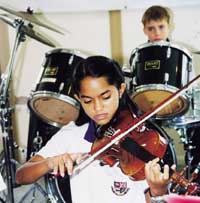 Marissa
playing the violin beautifully. Marissa
playing the violin beautifully.
Mr Lowder thanked all the children for their lovely
performances and the warm welcome that he had received from them.
After the assembly, the parents were invited to have
coffee and an informal chat with Head Elect together with Jill Thomas and
the company directors.
St. Andrews looks forward to an exciting future. Mr.
David Lowder arrives in August to officially take up his new posting as
Head of
St. Andrews International School. The boarding facilities, recently host
to a verysuccessful English Summer Camp, are due to be expanded shortly,
thus enabling St. Andrews to offer education up to the end of Key Stage 3.

Year
3 superstars!
St. Andrews International School is located at Green
Valley Golf Course, near Ban Chang, tel. (038) 893716 - 8, fax: (038)
893720, email: [email protected]
The teaching staff welcomes any visitors at any time.
Good as Gold
Wine Column by Ranjith Chandrasiri
Sauternes and its sub-appellation, Barsac, both located
in the southernmost part of Bordeaux, are treasure troves of wonderful
wines. This romantic region of low-lying hills and small valleys on the
banks of the Garonne is home to esteemed Chโteau d’Yquem whose
golden wines are famous around the world. Yquem is unquestionably the
world’s most collectable wine that fetches the highest prices at
auctions. Nature (soil + micro-climate) is the major factor in making this
inimitable wine, often referred to as liquid gold. However, without
Botrytis cinerea (noble rot) there would be no Yquem.
The liquid gold originates naturally in the sun’s
rays that cut through the autumn mists in the morning and voluptuously
ripen the grapes all afternoon. The special micro-climate created by the
confluence of the icy cold water of the small Ciron River with the Garonne
River foster the onset of Botrytis Cinerea, commonly known as “noble
rot”.
 Ranjith
Chandrasiri picking Noble Rot grapes recently in Chโteau Guiraud
Vineyard. Ranjith
Chandrasiri picking Noble Rot grapes recently in Chโteau Guiraud
Vineyard.
S้millon (also Muscadelle and Sauvignon Blanc) is
the best grape for making botrytis-affected sweet wines. In Sauternes, S้millon’s
fame springs from its dubious ability to rot well. Now, we are not talking
about any old mould but the noble rot. The reason for this mould’s
elevation is that instead of ruining the grapes, it enters the grapes’
thin, elastic skins, attacks the sugars stored in the berries, shrivels
and concentrates them. When these grapes are picked and pressed, they
extract a golden, sweet juice of unique concentration, bound up in a web
of exquisite fruit acidity. S้millon finds its finest expression at
Chโteau d’Yquem, the famous Sauternes estate that has preserved
the classic recipe for sweet white wines for centuries.
Making sweet wines is a heart-rending business. The
climatic conditions have to be just right. Too cold or wet weather during
harvest can provoke grey rot to which S้millon is also susceptible.
Harvesting must stop if it rains, because grapes need to come in perfectly
dry condition. Too hot weather just produces over-ripe grapes with high
sugar levels.
The next challenge is that the noble rot will not
attack all grapes at the same time. Growers must send their pickers out
into the vineyards several times to select only the most perfectly
“rotten” grapes. These selective pickings, called “tries” are
extremely labour intensive. During the last harvesting season, I tried my
hands at picking at the famous Chโteau Guiraud and I can say with my
own experience that you need to be a very experienced picker to tell the
difference, whether a grape is affected with noble rot or a bad rot. At Chโteau
Guiraud’s vineyards grapes are literally picked one by one, a process
not only tedious but it also accounts for very low yields. Instead of a
normal 50-60 hectolitres per hectare for dry white wines, we are talking
about yields of around 16-20 hectolitres per hectare. The often-quoted
comparison is that for most wines; a vine produces one bottle of wine, in
Sauternes a vine produces just one glass.
Sweet and semi sweet Sauternes wines have an incredible
ability to grow old gracefully. It starts its life being nursed in oak
barrels for two or three years in the cellar before being bottled. This
produces a whole realm of secondary aromas that add further layers of
complexity to the wine. Great vintages of Barsac and Sauternes can not
only age, but also actually improve over several decades developing
concentration, distinction and power unequalled by any other wine during
its life in the bottle.
Nectar-like sweetness in Sauternes wines, combined with
intense aromas of honey, spice, pear and tropical fruits, is sure to take
your palate to new heights. They are perfect as dessert wines or just
served on their own. Sweet Sauternes go well with fresh fruits, tarts and
anything else that has fresh acidity and medium sweetness. They are
increasingly popular as an aperitif or served with white meats, and are
delightful with foie gras or Roquefort cheese.
The only drawback to indulge in this sweet and gorgeous
stuff is that the best Sauternes don’t come cheap. For example a bottle
of 1994 Chโteau d’Yquem would cost 16,390 baht duty free. However,
many Sauternes (except for Chโteau d’Yquem) cost less, and in
great vintages they offer equally stunning quality. It’s best to go for
power and richness (signs of longevity) in young Sauternes.
With so many outstanding Sauternes to choose from, Chโteau
Climens (Premier Cru Class้), Chโteau Guiraud (Premier Cru
Class้) and Chโteau Doisy-Da๋ne (Deuxi่mes Crus)
and Chโteau Raymond-Lafon are my personal choices that I can afford
to buy.
Chโteau Doisy-Da๋ne, which is run by Pierre
Dubourdieu and his well-known oenologist son Denis Dubourdieu produces an
elegant sweet white wine (classic rating of 95-100 points for 2001 barrel
sample) and a delightful dry white wine with superb aromas and unique
subtle favours.
Chโteau Climens is one of the most consistent of
the premiers crus. Recently, in their winery I was privileged to
participate in a vertical tasting of its great vintages going back to
1961. In every vintage, this winery produced exceptionally good wines of
perfect elegance. What can I say, I am hooked. Barrel sample of Chโteau
Climens - 2001 has scored 95 - 100 points (Classic) and is described as
“incredibly racy. Intense! Super aromatic. Honey, dried pineapple,
minerals and superlush spice. Medium sweet. Electric to taste. Lasts for
minutes.” Need I say more?
According to my good friend Eric Hosteins, a highly
regarded n้gociant in Bordeaux, 2001 vintage is one to watch out for
outstanding Sauternes. Barrel samples of sweet wines from Sauternes and
Barsac appellations have fared incredibly well in the barrel tasting of
the 2001 vintage, which took place in Bordeaux just last March. It’s
important to note that these wines have not yet been bottled and will not
be shipped to buyers for another couple of years. Even though wines from
the preceding year’s harvest are typically barrel-tasted in late March,
prices from the top growths may not arrive until later in the year.
That’s how futures (en primeur) – the common
practice of selling wines in Bordeaux - work: with cash laid down in
advance for later delivery of wines that do not exist as a finished
product. Futures buyers must wait up to two years if the futures are
bought soon after they are first offered. The top producers, mainly the
first-growth chโteaux and a handful of other highly regarded
estates, effectively set the market price for a given vintage following
the barrel tasting in March. After courtiers, or brokers, take a small
percentage, the right to sell the futures is passed on to the n้gociants,
or shippers. With very few exceptions, no one deals directly with the chโteaux;
they deal with the n้gociants. Wine merchants, who are the closest
link to the consumer, buy the futures contracts from the n้gociants.
So if buying 2001 futures are in your future, you must find a reputable
merchant, one who can deliver the wine and whose futures prices are
realistic.
Buying futures can be a double-edged sword. While you
can make a killing buying an outstanding vintage at the right price you
can lose a fortune if you get it wrong. So, unless you are an experienced
wine trader, for most consumers it’s best to wait until the goods arrive
in the store.
For those who travel in and out of Thailand,
specialized wine boutiques such as Chโteau and Champagne (duty free)
at the Bangkok Airport present ideal hunting grounds for sought after wine
treasures. Best value Sauternes I found there were 1996 Chโteau
Raymond-Lafon (37.5cl) for 1,680 baht and 1997 Chโteau Raymond-Lafon
(37.5cl) for 1,590 baht and 75cl for 3,090 baht. Half bottle of liquid
gold - 1994 Chโteau d’Yquem was reasonably priced at 8,510 baht.
Ranjith Chandrasiri is the resident manager, Royal
Cliff Grand, Royal Cliff Beach Resort, Pattaya, Thailand. Email [email protected]
or [email protected]
|
|
|
|
News | Business News | Features | Columns | Letters | Sports | Auto Mania
Kid's Corner | Who’s Who | Travel | Our Community | Dining Out & Entertainment
Social Scene | Classifieds | Community Happenings | Books Music Movies
Club in Pattaya | Sports Round-Up
E-mail: [email protected]
Pattaya Mail Publishing Co., Ltd.
370/7-8 Pattaya Second Road, Pattaya City, Chonburi 20260, Thailand
Tel.66-38 411 240-1, 413 240-1, Fax:66-38 427 596
Copyright © 2002 Pattaya Mail. All rights reserved.
This material may not be published, broadcast, rewritten, or redistributed.
|
|
|





 Happy
trio, Jan, Kluay and Ying.
Happy
trio, Jan, Kluay and Ying.

 Gulfport,
Miss., native BU 1 (SCW) Wade Smith of Naval Mobile Construction Battalion
1 helps a class of Thai students speak English at the Wat Prachoommit
Bamroong School in Central Thailand. NMCB 1 built a multipurpose building,
giving students a sheltered place to eat and play. NMCB 1 is in Thailand
supporting this summer’s Cooperative Afloat Readiness and Training, an
annual exercise in the Western Pacific. U.S. Navy Photo by PHAN Jimmie
Crockett.
Gulfport,
Miss., native BU 1 (SCW) Wade Smith of Naval Mobile Construction Battalion
1 helps a class of Thai students speak English at the Wat Prachoommit
Bamroong School in Central Thailand. NMCB 1 built a multipurpose building,
giving students a sheltered place to eat and play. NMCB 1 is in Thailand
supporting this summer’s Cooperative Afloat Readiness and Training, an
annual exercise in the Western Pacific. U.S. Navy Photo by PHAN Jimmie
Crockett. Mr.
Robert Kennett, MD, thanks Jill Thomas.
Mr.
Robert Kennett, MD, thanks Jill Thomas. Mr.
Graham Sullivan (left) welcomes Mr. David Lowder.
Mr.
Graham Sullivan (left) welcomes Mr. David Lowder. Mr.
David Lowder presents a gift to Mrs Jill Thomas.
Mr.
David Lowder presents a gift to Mrs Jill Thomas. Marissa
playing the violin beautifully.
Marissa
playing the violin beautifully.
 Ranjith
Chandrasiri picking Noble Rot grapes recently in Chโteau Guiraud
Vineyard.
Ranjith
Chandrasiri picking Noble Rot grapes recently in Chโteau Guiraud
Vineyard.

